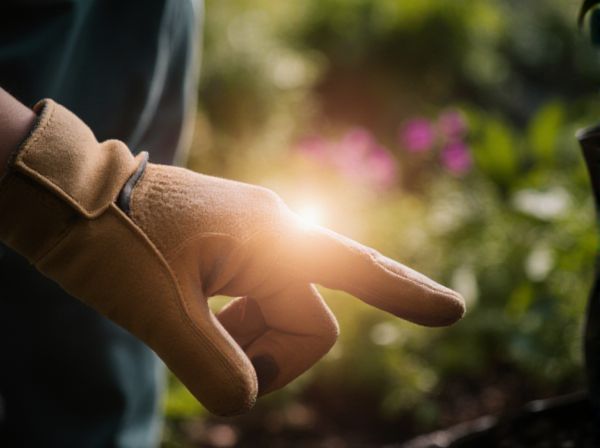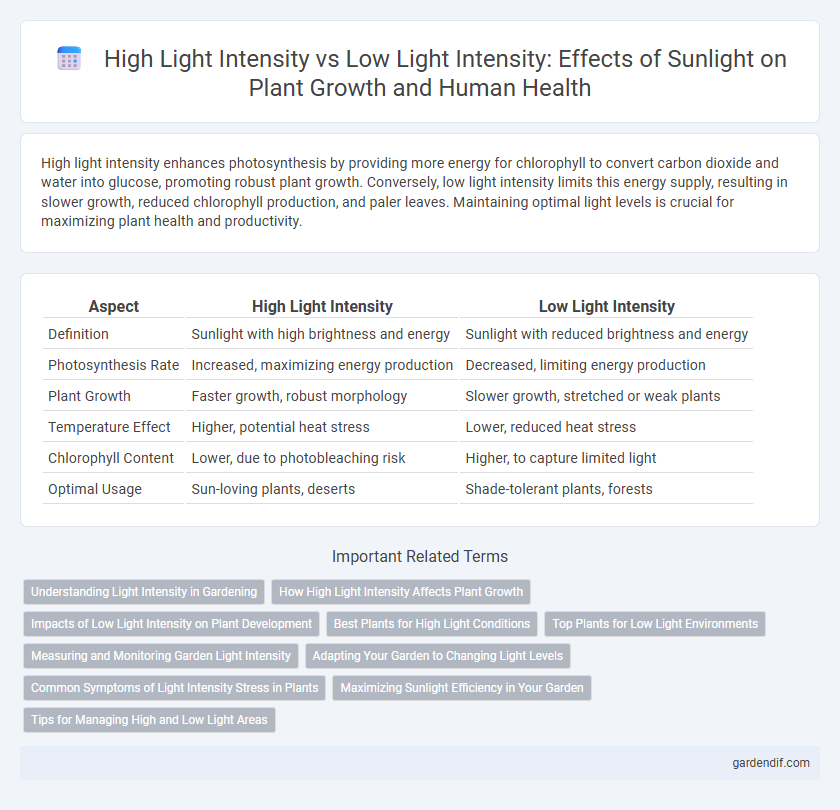
High Light Intensity vs Low Light Intensity Illustration
High light intensity enhances photosynthesis by providing more energy for chlorophyll to convert carbon dioxide and water into glucose, promoting robust plant growth. Conversely, low light intensity limits this energy supply, resulting in slower growth, reduced chlorophyll production, and paler leaves. Maintaining optimal light levels is crucial for maximizing plant health and productivity.
Table of Comparison
| Aspect | High Light Intensity | Low Light Intensity |
|---|---|---|
| Definition | Sunlight with high brightness and energy | Sunlight with reduced brightness and energy |
| Photosynthesis Rate | Increased, maximizing energy production | Decreased, limiting energy production |
| Plant Growth | Faster growth, robust morphology | Slower growth, stretched or weak plants |
| Temperature Effect | Higher, potential heat stress | Lower, reduced heat stress |
| Chlorophyll Content | Lower, due to photobleaching risk | Higher, to capture limited light |
| Optimal Usage | Sun-loving plants, deserts | Shade-tolerant plants, forests |
Understanding Light Intensity in Gardening
High light intensity delivers intense sunlight that promotes robust photosynthesis and faster growth in sun-loving plants like tomatoes and peppers. Low light intensity offers subdued illumination suitable for shade-tolerant species such as ferns and begonias, enabling slower but steady development. Understanding light intensity helps gardeners optimize plant health by matching species with appropriate sunlight exposure, ensuring maximum photosynthetic efficiency and vibrant growth.
How High Light Intensity Affects Plant Growth
High light intensity enhances photosynthesis by increasing the rate of energy absorption in chloroplasts, promoting faster plant growth and higher biomass production. Excessively high light can lead to photoinhibition, damaging the photosynthetic apparatus and reducing growth efficiency. Optimal light intensity balances energy capture and stress mitigation, ensuring maximal chlorophyll activity and nutrient assimilation.
Impacts of Low Light Intensity on Plant Development
Low light intensity severely limits photosynthesis, resulting in reduced energy production and slower plant growth. Plants exposed to low light often exhibit elongated stems, pale leaves, and diminished leaf size due to insufficient chlorophyll synthesis. Prolonged low light conditions can impair flowering, fruiting, and overall plant vigor, weakening resistance to pests and diseases.
Best Plants for High Light Conditions
Plants thriving in high light intensity environments require species with strong photosynthetic capabilities and tolerance to UV radiation, such as succulents, cacti, and flowering plants like bougainvillea and hibiscus. These plants optimize energy capture under intense sunlight, ensuring vigorous growth and vibrant blooms. Selecting species adapted to high light conditions reduces water stress and prevents leaf scorch, promoting long-term plant health.
Top Plants for Low Light Environments
Low light intensity limits photosynthesis, making it essential to select top plants adapted to minimal sunlight such as snake plants, pothos, and ZZ plants which thrive in shaded or indoor environments. These species have evolved efficient chlorophyll mechanisms to maximize light absorption under low light conditions, ensuring sustained growth and air purification. Understanding plant tolerance to varying light intensities enables optimal placement and care for indoor or shaded garden spaces.
Measuring and Monitoring Garden Light Intensity
Measuring garden light intensity involves using a lux meter or light sensor to capture precise data on sunlight exposure, crucial for plant growth optimization. High light intensity, typically above 10,000 lux, promotes photosynthesis but may cause leaf scorch in sensitive plants, while low light intensity below 5,000 lux can slow growth and reduce flowering. Consistent monitoring enables gardeners to adjust shading or supplemental lighting, ensuring optimal light conditions for diverse plant species.
Adapting Your Garden to Changing Light Levels
High light intensity causes plants to increase their production of protective pigments like carotenoids to prevent damage from ultraviolet radiation, while low light intensity prompts plants to maximize chlorophyll content to enhance photosynthesis efficiency. Gardeners should select shade-tolerant species such as ferns and hostas for low light areas and sun-loving plants like tomatoes and sunflowers for brighter spots. Adjusting watering schedules and soil nutrients can further support plant adaptation to varying sunlight levels, optimizing growth and health throughout seasonal changes.
Common Symptoms of Light Intensity Stress in Plants
High light intensity often causes leaf scorching, chlorosis, and stunted growth due to excessive ultraviolet radiation damaging chlorophyll molecules. Low light intensity results in elongated stems, pale leaves, and reduced photosynthetic efficiency as plants stretch to capture more light. Both extremes disrupt cellular processes and inhibit optimal plant development.
Maximizing Sunlight Efficiency in Your Garden
Maximizing sunlight efficiency in your garden requires understanding the difference between high light intensity and low light intensity conditions. High light intensity promotes vigorous photosynthesis and robust plant growth, especially for sun-loving species like tomatoes and peppers, while low light intensity suits shade-tolerant plants such as ferns and certain herbs, preventing stress and bolstering health. Strategic placement of plants based on their light requirements and using reflective surfaces or shading devices can optimize sunlight absorption and improve overall garden productivity.
Tips for Managing High and Low Light Areas
In high light intensity areas, use shading devices like blinds or UV-filtering films to protect interior spaces and prevent overheating. For low light intensity zones, incorporate reflective surfaces and strategically place artificial lighting to enhance brightness and maintain plant health. Balancing light conditions with these techniques supports energy efficiency and visual comfort indoors.
High Light Intensity vs Low Light Intensity Infographic

 gardendif.com
gardendif.com